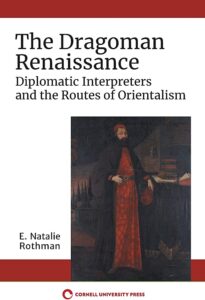
The Dragoman Renaissance Diplomatic Interpreters and the Routes of Orientalism by E. Natalie Rothman
 The age of dragomans: language and the origins of Orientalist scholarship
The age of dragomans: language and the origins of Orientalist scholarship
In the sixteenth century, Istanbul started evolving into a crucial center of diplomacy, attracting people from different walks of life.[1] As a multilingual and multi-confessional cosmopolitan space at the crossroads of Africa, Asia, and Europe, the city bred rivalry, rumors, conflict, and negotiation. A hub for diplomatic, missionary, and commercial activities, the Ottoman imperial city was home to many embassies and ambassadors who were accompanied by skillful dragomans (official translators). Despite the growing number of ambassadors at the Porte, the first Ottoman diplomatic residency in Europe was only established as late as 1793. This asymmetrical relation in early modern diplomacy was not uncommon since residential diplomacy was a European exception, rather than a norm at the time.[2] The length of tenure for European resident ambassadors in Istanbul averaged fewer than ten years in the sixteenth century and became longer in the seventeenth century.[3] Still, ambassadors were connected to a world by and large hidden from them, since the Ottoman court was successful in maintaining secrecy and limiting the dissemination of information.
The imperial ambassadors were mostly hosted in the Elçi Hanı—or Ambassadors’ Inn—near the hippodrome, which symbolically evoked the Ottoman state’s claim to the legacy of the Roman Empire. Moreover, by placing diplomatic agents in the heart of the city, the Ottomans were able to monitor foreigners’ activities and restrict their trafficking in and across Istanbul. Whether dragomans were recruited by European powers at the Porte and in European capitals or by the Ottoman Imperial Council (Divân-i Hümâyûn tercümanı), they all worked for different patrons and across several empires. As members of the bureaucratic corps, dragomans were textual practitioners who not only made meaning coherent and legible to their readers but also contributed to building the epistemic hierarchies and categories of statecraft. The primary index of such engagements can be traced within various inter-imperial transactions and diplomatic paper trails.
E. Natalie Rothman’s ambitious and sophisticated book, The Dragoman Renaissance: Diplomatic Interpreters and the Routes of Orientalism, shows that dragomans were indeed more than language experts and translators. They both shaped and circulated knowledge about the things Ottoman—politics, society, and language—to European audiences, while operating within the long-lasting structures of Mediterranean statecraft. Yet, as Rothman demonstrates, dragomans’ interpretive enterprise was far from constituting a unified practice; in fact, the extent of these key figures’ individual networks depended on their positionality and on the distinct epistemologies and methods they used in translating and recreating an Ottomanist discourse. The dragomans’ most obvious commonly held trait was that “they rarely embraced Islam and often enjoyed juridical status of non-Ottoman subjects” (10). Embracing and fostering a metropolitan sensibility, dragomans were often suspicious of the significance and authenticity of non-elite knowledge holders’ practices, whether Ottoman or otherwise. Consequently, the Ottomanist knowledge that the dragomans forged was intrinsically cosmopolitan and elitist.
The book’s main argument combines two trajectories, which until recently were conventionally understood to be distinct: diplomatic history, on the one hand, and, on the other, the long history of Orientalist thought. Approaching these two fields using an interdisciplinary methodology, Rothman aims to “challenge both spatial and temporal boundaries of Orientalism” (11). Even though the idea of a monolithic Orientalism as an ideological apparatus of the European colonial mind has been aptly criticized since the publication of Edward W. Said’s Orientalism,[4] the persistent legacy of rigid Orientalist thought has blanched all color of early modern encounters, in particular those between the West and the Islamic world. Rothman’s meticulous criticism of Saidian Orientalism deconstructs the genealogy of this narrative and offers a framework through which a more diverse and fine-grained history of Orientalism comes into view. In Rothman’s own words, The Dragoman Renaissance considers Orientalism “to be the culmination of specific communicative circuits and institutionalized genres of knowledge production that entangled Ottoman courtiers and scholars with diplomatic sojourners through complex, multidirectional processes of commensuration” (11). Building on the growing scholarship on premodern Ottoman self-fashioning in dialogue with European knowledge traditions and imperial rivals, Rothman’s study treats Orientalism as a hybrid and mediated form of knowledge production that emerged in trans-imperial sites.
So as to demonstrate the diverse and sometimes contradictory state of Orientalism peculiar to that historical conjuncture, Rothman employs a wide range of primary sources by reading them against the grain: dictionaries, grammar books, intertextual dialogues, diplomatic correspondence, and visual documents showing dragomans’ self-representation suggest that their intellectual and cultural capabilities operated through various mediums beyond linguistic expertise. In reviewing this material, Rothman emphasizes not only the imperial structures within which dragomans navigated but also their own semiotic practices as indications of an agency rife with self-conscious choices. Admittedly, dragomans’ kinship practices and networks—whether in the form of the patronage they secured, the strategic marriages they entered into, or the localized property they owned—reveal their in-between subject positions. Stepping into distinct life paths, dragomans followed various professional trajectories and did not merely compose a monolithic group of imperial interpreters.
The second half of the book is devoted to dragomans’ working methods, which impacted the way Europeans studied the Ottoman Turkish language and contributed to a republic of letters. Mediation was key in dragomans’ efforts to represent the Ottomans beyond stereotypical binaries. As indicated in the relevant historiography, Rothman notes, Ottoman scholars did not work in full isolation while composing their weighty historical manuscripts. For example, polymath Hezarfenn Hüseyin Efendi benefited from dragomans’ expertise in Latin and Greek sources while writing his universal history. Similarly, the renowned Kâtip Çelebi’s Kashf al-Zanūn was the immediate source for Barthélemy d’Herbelot’s Bibliothèque orientale, which constituted an imprint of local collaborations in Istanbul and beyond. As Rothman underscores, dragomans showed more interest in historical genres that were often imbued with court-centric sensibilities, and as a result, their translations “became foundational for ‘libraries,’ or rather catalogues raisonnés of Ottomanist knowledge, which served the basis for further textual production” (236). While Rothman acknowledges that knowledge produced by early modern Ottoman scholars was also shaped by dragomans’ epistemic priorities, this other side of the coin—how Ottoman counterparts benefited from collaborating with dragomans—is largely absent from the narrative arc of The Dragoman Renaissance. Informed by Rothman’s detailed and engaging book, however, further studies can build on this growing scholarship by unearthing both surprising and expected twists and dead ends in trans-imperial interactions—ones that include misunderstandings and preferred silences. Despite cosmopolitan Ottoman scholars’ enduring interest in foreign sources of knowledge and their collegial willingness to share books from their rich private libraries with Europeans, there were indeed some issues about which Ottoman subjects were deliberately discreet.
Rothman’s vision of modern Orientalism stretches back to early modern diplomatic interpreting, but a curious reader cannot help but wonder: if Orientalism is anything but coherent, what might be the other forces of agency that braided it? Were dragomans merely one group of knowledge brokers among many? Where can we situate various go-betweens, such as learned travelers, merchants, missionaries, and corsairs in the expansive map of the production of Ottomanist knowledge? The claim that The Dragoman Renaissance is more about European than Ottoman history would be untenable, regardless of the locales the book features. This study offers food for thought to redefine the legacy of Ottoman intellectual and diplomatic culture on the controversial idea of “the Orient.” Like any brilliant scholarship, Rothman’s research illustrates one clear path for this scholarship to consistently pursue what it promises to explore. By interpreting various sources in creative ways and reminding us of the fruitful intersection of diplomatic history, translation studies, and early modern Mediterranean and Ottoman histories, Rothman’s impressive book will surely become a classic for many fields, and deservedly so. It has already been awarded the Gladys Krieble Delmas Foundation Best Book Prize in Renaissance Venetian Studies in 2023; yet it will also be of interest to broader audiences, thanks to its captivating and elegant prose.
Duygu Yıldırım is assistant professor of history at the University of Tennessee, Knoxville. She holds a PhD in history from Stanford University (2021), and she is the co-editor of Natural Things in Early Modern Worlds (Routledge, 2023). Her scholarly publications have appeared or are forthcoming in the Journal of Ottoman Studies, History of Religions, and History of Science.
The Dragoman Renaissance: Diplomatic Interpreters and the Routes of Orientalism
By E. Natalie Rothman
Publisher: Cornell University Press
Paperback / 444 pages / 2021
ISBN: 1501758497
[1] Michael Talbot, British-Ottoman Relations, 1661-1807: Commerce and Diplomatic Practice in Eighteenth-Century Istanbul (Woodbridge: The Boydell Press, 2017); Güneş Işiksel, A diplomatie ottomane sous le règne de Selîm II: paramètres et périmètres de l’Empire ottoman dans le troisième quart du XVIe siècle (Paris Louvain Bristol, Ct: Peeters, 2016); Cihan Yüksel Muslu, The Ottomans and the Mamluks: Imperial Diplomacy and Warfare in the Islamic World (London: I.B. Tauris, 2014).
[2] Tracey Amanda Sowerby and Christopher Markiewicz, ed. Diplomatic Cultures at the Ottoman Court, c.1500-1630. (New York: Routledge, Taylor & Francis Group, 2021), “Introduction,” 7.
[3] Sowerby and Markiewicz, Diplomatic Cultures, 10-11.
[4] Edward W. Said, Orientalism (New York: Pantheon Books, 1978).
Published on July 12, 2023.




